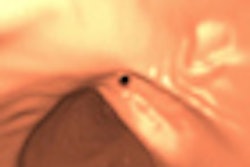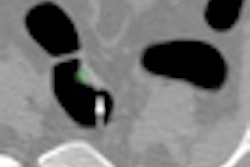
Establishing and running a successful CT colonography (CTC) service demands rigorous and robust planning that combines training, experience, and comprehensive quality assurance. Also, a multidisciplinary approach with locally agreed protocols and service objectives is vital to ensure quality and safeguard patients.
That's the central message of a practical article about the essential requirements of a CTC unit. The authors -- Dr. Anika Hansmann, PhD, and Dr. David Burling, both from the department of radiology at St. Mark's Hospital, Harrow, U.K. -- have the experience of developing their own CTC service from scratch, and their unit now examines more than 1,200 patients a year.
"A new CTC service should ideally be implemented in a stepwise fashion so that each part of the pathway can be refined and its impact monitored," they wrote in an article-in-press published online on 24 April by the European Journal of Radiology. "Auditing a program by analyzing this data helps quantify outcome and detect problems early. Databases should combine demographics with a rapid and easy system for monitoring local performance according to agreed 'key' performance indicators."
At the start of the process, it is essential to consider whether the team is planning to introduce CTC into an appropriate clinical environment and if sufficient enthusiasm and resources exist to develop a service, they noted. Also, it is vital to consider the national guidelines on CTC. For instance, U.K. teams implementing a new CTC service should initially develop their service for investigation of symptomatic patients, where it has an accepted role and where financial reimbursement is achievable. In the U.S., several states now recommend reimbursement of CTC as a primary screening test option, so it may therefore be appropriate to develop a "screening only" CTC service.
Members of the steering committee and their roles
|
"Recommendations and guidance on CT colonography practice and reimbursement will evolve over time and therefore target populations and their associated pathways can also be adapted accordingly," the authors wrote.
The demand for CTC in a particular region will be determined by factors like the general demand for colonic investigation (population age, sex, ethnicity, and socioeconomic demographics), colonoscopy provision and waiting lists, attitudes of local gastroenterologists and colorectal surgeons, and established referral pathways from general practitioners. Other factors include the number of trained radiologists with sufficient experience, CT scanner capacity, and radiology departmental priorities.
It is a good idea to visit any established centers in your area to learn from their experience and determine whether your plans will be complementary or competitive, they recommend.
"If complementary, you may be able to share protocols, expertise and provide support to each other for difficult cases, or even provide back up when capacity exceeds demand. We are aware of several 'lone' radiologists who have rapidly developed a CT colonography service but soon find themselves incapable of meeting demand -- or return from leave to find a lengthy caseload, with no trained colleagues to help report the backlog," the authors noted.
Members of the CT department will have the opportunity to extend clinical roles by undergoing specialized training and by active participation in the multidisciplinary CTC team. Examples of extended role for radiographers include performing and preliminary reading CTC under indirect supervision by a radiologist, managing the service, coordinating the rota, assessing the quality of the new service via audit, and research.
Protocols and management strategies to be agreed|
Pre-CT colonography
Peri-CT colonography
Post-CT colonography
|
"The CT colonography team is central to a program's success and members need to be highly motivated, competent, and willing to embrace new roles," the authors stated.
The director should be an experienced radiologist and a good communicator, with an enlightened attitude to the need for a quality assurance framework. He or she will usually have a subspecialty interest in gastrointestinal radiology and suitable training experience, including two days or more of hands-on experience at a CTC workshop and where available, a dedicated "Train the Trainers" course. Typically, the director will interpret more than 100 scans per year to enable meaningful audit of his or her results. The director should develop a clear team structure, where members are aware of their role, objectives, competencies, and opportunities for training and role extension, they recommend.
The authors urge the director to bring together a steering group, prior to service delivery, which allocates resource and responsibility across the team and engages with stakeholders to predict problems and develop strategies to deal with them before they occur. Obtaining resources and gaining support from stakeholders often requires a strong business case, and the director should be the principal author of this.
"The director will delegate tasks appropriately within the team to share the responsibility for workload and success and to keep members actively engaged in the service. Good delegation can motivate staff but this requires excellent communication skills to ensure tasks are undertaken accurately and on time," they wrote.
The program coordinator is the lynchpin of the team, and must be involved in all aspects of the service. This person is usually a senior radiographer with a declared interest in colorectal cancer, and will be focused on quality, efficiency and patient experience in day-to-day practice.
At St. Mark's, a patient's first encounter with the CTC service is often via a phone call with the program coordinator, who will give reassurance and advice about bowel preparation, diet and the logistics of examination. This interaction is key to improving patient experience and helping to ensure compliance with bowel preparation regimens.
"The coordinator will be the patient's closest ally throughout the pathway, assisting communication between patient and medical team. To do so, the coordinator must be knowledgeable about bowel cancer and very experienced with patients. Our coordinator also supervises patient consent for examination and retrospective audit of their data, which requires both tact and efficiency," they stated.
The program coordinator will often interface with clinical referrers, and the quality of this interface will influence popularity of the CTC service. At St. Mark's, the coordinator communicates directly with patient and endoscopists when planning same day endoscopy for biopsy of detected cancers. The coordinator ensures a timely report is made available to the surgical team and family practitioner, and checks a management plan has been implemented. The program coordinator is also responsible for helping assess appropriateness of referrals, and should regularly appraise individuals to receive feedback and encourage sharing of ideas, according to the authors.
To achieve success, there needs to be excellent cooperation and understanding between endoscopy and radiology departments, and the authors strongly recommend radiologists and their team members develop strong links with individual colleagues in endoscopy to facilitate evolution of their service.
"Radiologists are reliant on advocacy and support for their new service and this will be more likely in a 'quid pro quo' relationship between teams. The gastroenterologist, ideally leading the endoscopy service, will therefore be a prime member of the CT colonography team, albeit in an allied role," they noted.
The authors stress the importance of individualizing a patient pathway (choice of investigation, examination protocol and management recommendations) according to the target of the test, i.e., small polyp, advanced polyp, colorectal cancer or extra-colonic cancer. A joint strategy for colorectal investigation will help an organization distribute resources and manage demand. Adding CTC to can help reduce endoscopy waiting lists, whilst more safely investigating co-morbid patients, they concluded.



















